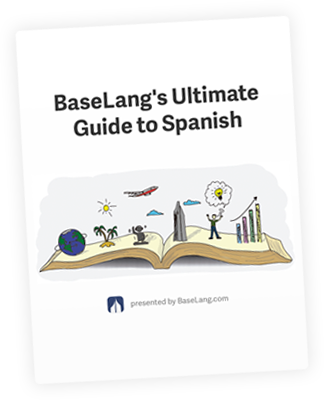Demonstrative Adjectives in Spanish: A simple guide to Este, Ese, and Aquel

Get our free email course, Shortcut to Conversational.
Have conversations faster, understand people when they speak fast, and other tested tips to learn faster.
More infoWhen we need a word that can help us point to a specific object, group of objects, person, place, etc., a demonstrative adjective is the solution. In English, the demonstrative adjectives are this, that, these, and those.
As the name suggests, these words make it possible to demonstrate or point out what we’re talking about. In this case, we use the noun’s location to identify it.
What Are Demonstrative Adjectives in Spanish?
Demonstrative adjectives help us identify and distinguish nouns that we want to talk about. Like typical adjectives, these words modify a specific noun. In Spanish, adjectives change form depending on the noun they modify, and demonstrative adjectives are no exception.
In English you have two scales of distance, each with singular and plural forms, so a total of four demonstrative adjectives: this, that, these, and those. In Spanish, however, there’s a third level of distance, plus the masculine and feminine forms, so there are actually 12 words to know!
Sound like a headache? Don’t worry, there are really just three base words to learn, each with their four forms.
When choosing a demonstrative adjective, there are three things to worry about: the gender of the noun you’re modifying, the noun’s number or quantity, and distance.
The ending is either -a for feminine nouns, or -o or -e for masculine nouns, while we simply add an s for demonstrative adjectives modifying plural nouns.
This third factor is where Spanish demonstrative adjectives are distinct from their English counterparts. Rather than just two two scales of distance between this and that, in Spanish we have a third level of distance: we use este, ese, and aquel for close, near, and far nouns. We’ll go into more detail on how to choose between ese and aquel in the next section.
Here are all the demonstrative adjectives Spanish uses for the three scales of distance:
| Demonstrative adjectives: Spanish | Demonstrative adjectives: English |
| este, esta, estos, estas | this, these (close) |
| ese, esa, esos, esas | that, those (near) |
| aquel, aquella, aquellos, aquellas | that, those (far) |
You may have noticed that the demonstrative adjectives used for close nouns have t’s in them, while the demonstrative adjectives for the next distance of nouns are almost the same, just without t’s.
Here’s a great mnemonic device that may help you recall which demonstrative between este or ese matches which English word between this and that:
This and these both have t’s, but that and those don’t.
You could also remember to “keep your t’s close.”
Demonstrative adjectives: Spanish singular for This and That
The Spanish words este / esta, ese / esa, and aquel / aquella can all be used to modify a singular noun at the three scales of distance. Note that for the farthest scale, we need to double the l’s for the other forms of aquel.
| Masculine form | Feminine form | English equivalent |
| este | esta | this |
| ese | esa | that |
| aquel | aquella | that |
Demonstrative adjectives: Spanish plural for These and Those
To describe a noun that’s plural, we use estos / estas, esos / esas, or aquellos / aquellas.
| Masculine form | Feminine form | English equivalent |
| estos | estas | these |
| esos | esas | those |
| aquellos | aquellas | those |
Note that unlike the masculine singular forms, the masculine plural forms of these adjectives use an -o ending rather than an -e.
Demonstrative adjective placement
Demonstrative adjectives are generally placed immediately before the noun they’re modifying. The adjective must agree with the noun.
Check out these examples of demonstrative adjectives in action:
- This pizza is very large. – Esta pizza es muy grande.
- My friend likes that store. – A mi amigo le gusta esa tienda.
- Can you hear those geese? – ¿Pueden oír aquellos gansos?
Ese o Aquel: How to Choose the Right Demonstrative Adjective
One of the trickiest parts of working with demonstrative adjectives is differentiating between our options based on how far away the noun you’re describing is.
Este in all its forms always translates to this or these, whereas both ese and aquel (and their variants) are translated into English as that and those. So how do we know which one to use?
Though it’s typically safe to use ese to modify a noun that’s far away from you, aquel, though less common, is the best choice for things that are very far away in location or time. Keep an eye out for clue phrases like “over there” that make it simple to choose the correct word.
We also sometimes use aquel to talk about metaphorical or theoretical ideas, such as an aforementioned concept in a conversation.
But don’t stress! Many times, aquel and ese can be used interchangeably.
Este: Things that are close to both the speaker and listener
For things that are nearby, we use este or one of its variants: esta, estos, or estas. These nouns are often close enough to touch, or at least right in front of us.
- I love this store; it’s my favorite. – Me encanta esta tienda; es mi favorita.
- These shoes are too tight. – Estos zapatos son demasiado apretados.
Ese: Things that aren’t close to the speaker, but might be close to the listener
To modify a noun that’s not close to you as the speaker, but may be close to the listener (i.e. an object on the other side of the room near the listener), we use ese and its variants: esa, esos, esas. That noun is generally close enough that it’s clear what we’re referring to, but not immediately close to the speaker.
- I need that notebook for my next class. – Necesito ese cuaderno para mi próxima clase.
- Those cupcakes aren’t very tasty. – Esas magdalenas no están muy ricas.
Aquel: Things that are far away from both the speaker and listener
When talking about a noun that’s very far removed from both parties, we use the word aquel and its variants: aquella, aquellos, aquellas. When speaking, you’ll generally need to point at that thing if you’re using aquel, since it’s fairly far away.
- That car is my sister’s. – Aquel auto es de mi hermana.
- I’d like to buy those earrings over there. – Me gustaría comprar aquellos aretes.
Este, ese, and aquel correspond to aquí, ahí, and allí
A good way to remember which adjective correlates with each degree of distance is noting that each word corresponds to the three Spanish place words for “here” and “there.” If you’re unfamiliar with them, check out our dedicated post on here and there in Spanish. See how each of these relate:
| este | aquí |
| ese | ahí |
| aquel | allí |
A note on demonstrative pronouns
You may notice that demonstrative adjectives in Spanish are the same words as demonstrative pronouns in Spanish.
Each demonstrative can be used as either an adjective or a pronoun depending on what you’d like your sentence to say:
- I like these shoes. – Me gustan estos zapatos.
- I like these. – Me gustan éstos.
In the first example, the word “these” acts as an adjective modifying the word “shoes” (to describe and point out which shoes we’re talking about). In the second, the word “these” replaces the noun and stands on its own.
Accents (placed on the stressed vowel, always an “e”) are typically used to distinguish demonstrative pronouns from adjectives, but modern grammar conventions have shifted this rule and made the accent optional.
Conclusion: Demonstrative Adjectives in Spanish
This, that, these, those: there are literally a dozen corresponding words to point out objects, people, and other nouns in Spanish, but that doesn’t mean you can’t master them! We’ve just covered all the forms of ese, este, and aquel for saying this and that in Spanish, giving a particular focus to the nearby and distant scales of distance differentiating the three of them.
For further practice, try filling in this chart divided up by gender, number, and degree of distance and filling in all the Spanish demonstratives. We’ve started you off with one version of each. Check the very end of the post for the full chart.
| distance | masculine singular | feminine singular | masculine plural | feminine plural |
| close | esas | |||
| near | este | |||
| far | aquellos |
Demonstrative Adjectives: Spanish Exercises
Are you ready to practice what you’ve just learned? To complete this activity, take a look at the original Spanish sentence as well as its English translation. Use the English translation to decide which demonstrative adjective would best fill in the blank left in the Spanish sentence.
Remember to consider gender, number, and distance as you work. Keep track of your answers to each question, then compare them with the completed sentences below.
1. Quiero _____ vestido para mi fiesta de cumpleaños.
– I want this dress for my birthday party.
2. _____ bufanda es un regalo de mi abuela.
– That scarf is a gift from my grandma.
3. Me gustan _____ collares en exhibición, pero no tengo el dinero suficiente para comprarlos.
– I like those necklaces on display, but I don’t have enough money to buy them.
4. ¿Tu esposo te dio _____ anillo?
– Did your husband give you that ring?
5. _____ rebanadas de pan están duras.
– These slices of bread are stale.
6. ¿Ves a _____ mujer allí?
– Do you see that woman over there?
7. Prefiero _____ sandalias.
– I prefer these sandals.
8. Lupe se va a comer _____ burrito.
– Lupe is going to eat that burrito.
9. Me interesa _____ documental.
– I’m interested in this documentary.
10. _____ manzana y _____ naranjas allí están frescas.
– This apple and those oranges over there are fresh.
Answers
1. Quiero este vestido para mi fiesta de cumpleaños.
2. Esa bufanda es un regalo de mi abuela.
3. Me gustan esos collares en exhibición, pero no tengo el dinero suficiente para comprarlos.
4. ¿Tu esposo te dio ese anillo?
5. Estas rebanadas de pan están duras.
6. ¿Ves a aquella mujer allí?
7. Prefiero estas sandalias.
8. Lupe se va a comer ese burrito.
9. Me interesa este documental.
10. Esta manzana y aquellas naranjas allí están frescas.
All the Spanish Demonstrative Adjectives
As promised in the conclusion, we’ll end here with a final table showing all twelve forms of the demonstrative adjectives in Spanish:
| distance | masculine singular | feminine singular | masculine plural | feminine plural |
| close | ese | esa | esos | esas |
| near | este | esta | estos | estas |
| far | aquel | aquella | aquellos | aquellas |




